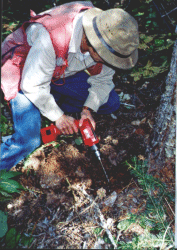
Dr. Kathy J. Lewis
Associate Professor, Ecosystem Science and Management (Forestry)
BSc
(British Columbia), MSc (Virginia Polytech
and State), PhD (Oregon State)
Telephone:
(250) 960-6659 Fax:
(250) 960-5538 lewis@unbc.ca

My research interests are primarily in the fields of forest pathology and microbial ecology. I study how disease-causing organisms interact with their physical and biological environments in forest ecosystems, and how forest management practices can affect those interactions. My hypothesis is that in natural multi-species sub-boreal systems, forest insects and pathogens control dynamics at the small scale (e.g., tree by tree replacement), and that the ecosystems have developed in the presence of these agents and therefore there is quasi-equilibrium between hosts and pathogens. Changes in composition or factors affecting tree vigour will affect mortality rate and gap sizes, and create disequilibrium.
I have two main areas of research: 1) stand dynamics (stand age and size structure, species composition, recruitment and mortality rates) resulting from biotic disturbance agents; 2) epidemiology and population genetics of forest pathogens and resultant impacts of forest management practices.
Current projects include the following:
Examination of the distribution and severity of past outbreaks of Dothistroma septospora in northwestern B.C. and relationships with past climate.
Refereed Journals, Books, and Proceedings
Lewis, K.J. and Hartley, I.D. 2006. Rate of deterioration, degrade, and fall of trees killed by mountain pine beetle. Journal of Ecosystems Management 7:11-19.
Lewis, K.J., Thompson, R.D. and Trummer, L.T. 2005. Growth response of spruce infected by Inonotus tomentosus in Alaska and interactions with spruce beetle. Can. J. For. Res. 35: 1455-1463.
Durrall, D.M., Jones, M.D. and Lewis, K.J. Effects of forest management on fungal communities. In: The Fungal Community, Its Organization and Role in the Ecosystem. 3rd ed. Edited by J. Dighton, J.F. White, and P. Oudemans. Taylor & Francis, Boca Raton, Florida.
Lewis, K.J., Trummer, L.T. and Thompson, R.D. 2004. Incidence of tomentosus root disease relative to spruce density and slope position in south-central Alaska. Forest Ecology and Management 194: 159-167.
Newbery, J.E., Lewis, K.J. and Walters, M.B. 2004. Estimating time since death of Picea glauca x engelmannii and Abies lasiocarpa in wet-cool sub-boreal spruce forests. Can. J. For. Res. 34: 931-938.
Lewis, K.J. 2003. Forestry and Forests in New Caledonia. J. of Western Geography 12:185-215.
Parsons, S.E., Lewis, K.J. and Psyllakis, J. 2003. Relationships between roosting habitat of bats and decay of aspen in the sub-boreal forests of British Columbia. Forest Ecology and Management. 177: 559-570.
DeLong, R.L, Lewis, K.J., Simard, S.W and Gibson, S. 2002. Fluorescent pseudomonad population sizes baited from soils under pure birch, pure Douglas-fir and mixed forest stands and their antagonism toward Armillaria ostoyae in vitro. Can. J. For. Res. 32: 2146-2159.
Lewis, K.J. and Lindgren, B.S. 2002. Relationship between tomentosus root disease and spruce beetle: two natural disturbance agents of spruce. Can. J. For. Res. 2002. 32: 31-37
Lewis, K.J. and Lindgren, B.S. 2000. A conceptual model of biotic disturbance ecology in the central interior of B.C.: How forest management can turn Dr. Jekyll into Mr. Hyde. Forestry Chronicle, 76:433-444.
Lindgren, B.S., Lewis, K.J. and Gregoire, J-C. 1999. Notes on the abundance and host preference of Dendroctonus punctatus (Coleoptera: Scolytidae) in spruce forests near Prince George, B.C. Journal of the B.C. Entomological Society. 96:69-72.
Rocchini, L.A., Lewis, K.J., Lindgren, B.S., and Bennett, R.G. 1999. Association of Pitch Moths (Leptidoptera: Sesiidae and Pyralidae) with rust diseases in a lodgepole pine provenance trial. Canadian Journal of Forest Research. 29:1-5.
Bernier, D. and Lewis, K.J. 1999. Site and soil factors and the incidence of tomentosus root disease. Forest Ecology and Management. 120: 131-142
Lewis, K.J. and Lindgren. 1999. Influence of decay fungi on species composition and size class structure in mature Picea glauca x engelmannii and Abies lasiocarpa in sub-boreal spruce forests of central British Columbia. Forest Ecology and Management. 123: 135-143.
Lewis, K.J. 1997. Growth reduction in spruce infected by Inonotus tomentosus in central British Columbia. Can. J. For. Res. 27:1669-1674.
Thomson, A.J., Muir, J. and Lewis, K. 1997. Estimating regional impacts of lodgepole pine dwarf mistletoe in BC. Forestry Chronicle 73:371-375.
Lewis, K.J. 1996. Aspen decay and wood utilization. In: Comeau, P.G., G.J. Harper, M.E. Blache, J.O. Boateng and K. D. Thomas (editors). Ecology and Management of B.C. Hardwoods. Workshop Proceedings, December 1 & 2, 1993, Richmond, B.C. Ministry of Forests FRDA Report No. 255
Lewis, K.J., Morrison, D.M. and Hansen, E.M. 1992. Spread of Inonotus tomentosus from infection centres in spruce forests of British Columbia. Can. J. For. Res. 22: 68-72.
Lewis, K.J. and Hansen, E.M. 1991. Survival of Inonotus tomentosus in stumps and subsequent infection of young stands in north central British Columbia. Can. J. For. Res. 21:1049-1057.
Lewis, K.J. and Hansen, E.M. 1991. Vegetative compatibility groups and protein electrophoresis indicate a role for basidiospores in spread of Inonotus tomentosus in spruce forests of British Columbia. Can. J. Bot. 69: 1756-1763.
Lewis, K.J. and Alexander, S.A. 1986. Insects associated with the transmission of Verticicladiella procera. Can. J. For. Res. 16:1330-1333.
Lewis, K.J., Alexander, S.A. and Horner, W.E. 1987. Distribution and efficacy of propagules of Verticicladiella procera in soil. Phytopathology 77:552-556.
Horner, W.E. Alexander, S.A. and Lewis, K.J. 1987. Colonization patterns of Verticicladiela procera in scots and eastern white pine and associated resin soaking, reduced sapwood moisture content, and reduced needle water potential. Phytopathology 77:557-560
Other Recent Proceedings & Abstracts
Thompson, R.D., Lewis, K.J., and Daniels, L. 2005. Stand level spatio-temporal disturbance patterns in mature, spruce-subalpine fir forests found in the central interior of British Columbia. North American Forest Ecology Workshop, Ottawa, Ontario. Abstr.
Thompson, R.D., Daniels, L. and Lewis, K.J. 2005. A new dendroecological method to separate responses to overhead tree mortality from climate. Association of American Geographers. Abstr.
Lewis, K.J. 2004. Pathogens and their influence on fire risk and severity in boreal and sub-boreal forests of Canada: Pandora's box or pipe dream? Canadian Institute of Forestry/Society of American Foresters joint meeting. Oct. 2-6, 2004, Edmonton Alberta. Invited Presentation, published proceedings. Invited
Gibson, S. and Lewis, K.J. 2004. Genetic diversity of Inonotus tomentosus in natural and managed sub-boreal spruce forests in British Columbia. International Union of Forest Research Organizations, Root and Butt Rots Working Party. Poznan, Poland, Aug. 16-22, 2004.
Lewis, K.J., Trummer, L.T. and Thompson, R.D. 2004. Growth response of spruce infected by Inonotus tomentosus in south-central Alaska and interaction with spruce beetle. 12th International Boreal Forest Research Association Conference. Fairbanks Alaska, May 2004. Poster.
Lewis, K.J. 2004. Forest Pathogens and the "Whoops!" Approach to Silviculture. Western International Forest Disease Work Conference and Western Forest Insect Work Conference. San Diego, CA. April 26-30, 2004. Invited Presentation, published proceedings. Invited
Gibson, S. and Lewis, K.J. 2004. An investigation of genetic diversity to understand disease spread: examining tomentosus root rot in spruce stands of the central interior. Interactive Innovation Conference. Feb. 27th, 2004. Prince George, BC. Poster.
Lewis, K.J., Thompson, R.D, and Trummer, L.T. 2004. Growth response of spruce infected by Inonotus tomentosus in spruce beetle affected forests in south-central Alaska. A Changing Alaskan Forest Ecosystem Effects of Spruce Beetle Outbreaks and Associated Management Practices on Forest Ecosystems in South-central Alaska. February 24-26, 2004, Homer, Alaska. Poster
Lewis, K.J. 2003. Ecosystem based management. McGregor Model Forest Showcase 2003. Invited
Gibson, S. and Lewis, K.J. 2002. Genetic diversity in Inonotus tomentosus. 4th International Workshop on Disturbance Dynamics in Boreal Forests, Aug. 9-14, Prince George, BC, Canada. Poster
Lewis, K.J. 2002. Bugs, Bats and other Biota: Relationships with pathogens and forest management in wet (but not too wet) ecosystems. In Proceedings of the Western and International Forest Disease Work Conference, Oct. 9-12, Powell River, BC. Invited
Newbery, J.E., Lewis, K.J. and Walters, M. 2002. Disturbance and succession in sub-boreal forests: impacts of Inonotus tomentosus and partial cut harvesting. 4th International Workshop on Disturbance Dynamics in Boreal Forests, Aug. 9-14, Prince George, BC, Canada. Presentation.
Thompson, R.D., Lewis, K.J. and Trummer, L. 2002. Growth response of spruce in south-central Alaska: results of an interaction between tomentosus root disease and spruce beetle. 4th International Workshop on Disturbance Dynamics in Boreal Forests, Aug. 9-14, Prince George, BC, Canada. Poster
Lewis, K.J., Trummer,
L., Parsons, S. and Thompson, R.D. 2001. Site and soil factors and tomentosus
root disease incidence in south-central Alaska. In Proceedings of the International
Union of Forest Research Organizations. Root Rot working party. Quebec, Sept.
17-21, 2001.
Recent Technical Reports
Lewis, K.J. and Hartley, I. 2005. Rate of deterioration, degrade and fall of trees killed by mountain pine beetle: a synthesis of the literature and experiential knowledge. Natural Resources Canada, Canadian Forest service, Pacific Forestry Centre. 20p.
Lewis, K.J., Stevenson, S., Lindgren, B.S., Thompson, R.D., and Bismanis, A. 2003. Ecosystem Based Management - Research Development Plan. McGregor Model Forest, Phase III.
Lewis, K.J. 1999.
Tomentosus root disease in spruce in south-central Alaska. USDA For. Serv. Report.
Anchorage, Alaska
Environmental Appeal Board, 2002 to present
Forest Appeals Commission, 1997 to present
Co-chair, Chuzghun Resources Inc. Board of Directors
Association of B.C Forest Professionals
FSTY 307 - Forest Health
Forest pathogens and insects have major effects on forest vegetation and ecosystem dynamics. They are critical elements of natural ecosystem processes, but under some circumstances can cause undesirable changes in ecosystems. The purpose of this course is to link the biology and natural roles of insects and pathogens with the economic and ecological factors that cause them to become pests.
NREM 100 - Natural Resource Management I
Introduction to basic field skills in the natural resources including orienteering, surveying, first aid, outdoor survival, and search and rescue.
NREM 101 - Natural Resource Management II
This course is designed for students who are interested in natural resources and considering a career in natural resources management. The course will explore the past social and political actions and present developments that have shaped the natural resources disciplines of fisheries management, wildlife management, forestry and range management. The course will provide a context for resource policies and practices, and will examine the decision-making process in land-use decisions. Course activities and assignments are intended to promote critical thinking skills and an ability to synthesize information and express coherent arguments.
BIOL 421/611-3 - Insects, Fungi, and Society
From LSD to the Exodus, and from malaria to the Civil War, fungi and insects have played important, but largely ignored, roles in society. In this course we explore the ecological and societal impacts of two of the most abundant groups of organisms on Earth. We examine the biological properties and ecological relationships of insects and fungi that have lead to major changes in where and how people live.
BIOL 401/631-3 - Plant-Microbe Interactions
Parasitic diseases and mutualistic associations of plants, especially forest trees. Emphasis is placed on the ecology and phylogeny of fungal plant pathogens and mycorrhizal symbionts, and the physiology of plant-microbe interactions.
NRES 730-3 - Disturbance Ecology
A graduate level course that examines natural disturbance agents and patterns in sub-boreal and boreal forests, with an emphasis on biotic agents of disturbance.
Current Students and Research Projects
|
Cedar Welsh - MSc candidate. Relationships between climate, forest practices and incidence of Dothistroma septospora. |
 |
|
Angie Dale - MSc candidate. Genetic variation in the foliar pathogen Dothistroma septospora and relationship to toxin production. |
Graduate
Research Opportunities
1. PhD student opportunity: Dr. Kathy Lewis (Ecosystem Science and Management) and Dr. Gail Fondahl (Geography)
Examining the role of anthropogenic factors in shaping past and current landscapes in Tl'azt'en territory, through qualitative and quantitative methodologies. Student research assistantship available for September 2006. For more information, contact Kathy Lewis at lewis@unbc.ca.
2. PhD student opportunity:
Using Reconstructed Histories of Mountain Pine Beetle, Fire and Climate to Predict the Risk of Future Outbreaks. Student research assistantship available starting spring 2006. For more information, contact Kathy Lewis at lewis@unbc.ca.
3. MSc student opportunity:
Disease development and spore production by Dothistroma septospora:
the role of topography and mesoscale climate. Student research assistantship
available May 2006. For more information, contact Kathy Lewis at lewis@unbc.ca.